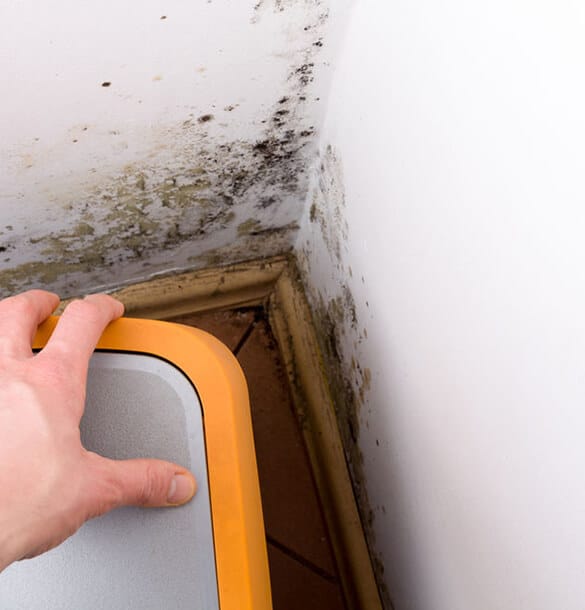Situating Post Remediation Inspection Near Me Services
Wiki Article
Professional Tips for Post Mold And Mildew Remediation Success
In the realm of mold remediation, effectively getting rid of mold and mildew is just half the fight; the real obstacle exists in stopping its reappearance. Post-remediation efforts play an important function in making sure a mold-free atmosphere in the long-term. By adhering to professional tips and finest methods, people can secure their areas against mold resurgence and maintain a healthy indoor environment. It remains in this stage of the removal procedure that interest to detail and positive steps truly make a difference.
Screen Humidity Degrees Regularly
After finishing mold and mildew remediation treatments, keeping optimum humidity levels is critical to avoid mold and mildew re-growth and make sure a healthy indoor atmosphere. High humidity levels above 60% produce a conducive atmosphere for mold to flourish, making normal checking a proactive step to stop any future mold and mildew concerns.Additionally, developing a routine schedule for humidity checks, particularly in risky areas such as restrooms, cooking areas, and cellars, is a proactive technique to mold and mildew avoidance. By regularly keeping track of humidity levels, home owners can efficiently alleviate the danger of mold and mildew reoccurrence and keep a healthy interior atmosphere post-remediation.
Conduct Thorough Inspections Post-Remediation
Following the conclusion of mold remediation treatments, it is imperative to conduct detailed inspections to verify the effectiveness of the removal process. These post-remediation evaluations are essential in ensuring that the mold issue has actually been successfully addressed which there is no reappearance or remaining mold development. Examinations ought to be performed by qualified specialists who have proficiency in identifying mold and mildew and examining interior air quality.During these examinations, various techniques such as visual assessments, air tasting, and surface sampling might be employed to thoroughly assess the remediated locations. Aesthetic assessments involve a thorough assessment of the properties to look for any type of noticeable signs of mold development or water damage. Air sampling assists in identifying the airborne mold spore degrees, while surface area sampling can spot mold and mildew bits on surfaces.
Implement Correct Ventilation Methods
After guaranteeing the performance of the mold removal procedure through detailed assessments, the next crucial step is to concentrate on executing correct ventilation approaches. Sufficient ventilation is important in protecting against mold reoccurrence by regulating dampness degrees and promoting air flow.
Appropriate air flow not just help in avoiding mold and mildew growth but additionally adds to the overall health and comfort of owners. By making certain ample air flow throughout the home, you can lower the threat of mold and mildew regrowth and produce a much healthier living environment. Regular upkeep of air flow systems, consisting of cleaning and filter replacements, is vital to sustaining effective ventilation. Consulting with cooling and heating specialists can supply further understandings right into enhancing air flow techniques for your specific residential or commercial property requirements.

Usage Mold-Resistant Products for Fixes
To boost the lasting performance of mold and mildew remediation initiatives, incorporating mold-resistant products for fixings is essential in alleviating the risk of future mold growth. Mold-resistant products are made to endure dampness and prevent mold growth, making them an important selection for areas vulnerable to dampness and humidity. When fixing areas impacted by mold, utilizing products such as mold-resistant drywall, mold-resistant paints, and mold-resistant caulking can aid stop mold reappearance.Mold-resistant drywall is a superb choice to typical drywall in locations like bathrooms and basements where moisture degrees are higher. When subjected to damp conditions, this type of drywall has an unique coating that resists mold growth also. Additionally, making use of mold-resistant paints including antimicrobial agents can even more hinder mold development on walls and ceilings.
In locations where wetness prevails, such as bathrooms and kitchen areas, utilizing mold-resistant caulking around sinks, home Post Remediation verification windows, and tubs can assist secure out water and stop mold from holding in splits and gaps. By purchasing these mold-resistant products throughout repair work post-remediation, you can significantly reduce the chance of future mold problems and maintain a healthier interior environment.
Maintain Cleanliness and Address Water Issues
After mold removal, it is vital to preserve a clean atmosphere to stop the regrowth of mold. Leakages, water breach, or high moisture levels can produce the perfect reproduction ground for mold, so it is necessary to fix any type of water-related issues quickly.To keep sanitation, take into consideration using HEPA filters in vacuum cleaners and air cleansers to trap mold spores and stop their flow in the air. Making certain appropriate air flow in areas susceptible to moisture accumulation, such as cooking areas and shower rooms, can assist maintain moisture degrees in check. By remaining watchful regarding cleanliness and resolving water concerns quickly, you can effectively avoid mold reinfestation and keep a healthy indoor setting.
Final Thought

In the world of mold and mildew remediation, successfully eliminating mold is only half the battle; the real difficulty lies in stopping its reappearance. After completing mold and mildew removal procedures, preserving optimum moisture degrees is vital to prevent mold re-growth and ensure a healthy indoor atmosphere. High humidity degrees above 60% create a helpful setting for mold to thrive, making regular keeping track of a proactive procedure to stop any type of future mold issues.
To improve the long-term efficiency of mold remediation initiatives, integrating mold-resistant products for repairs is essential in reducing the threat of future mold and mildew development. After mold remediation, it is vital to keep a tidy setting to avoid the regrowth of mold.
Report this wiki page